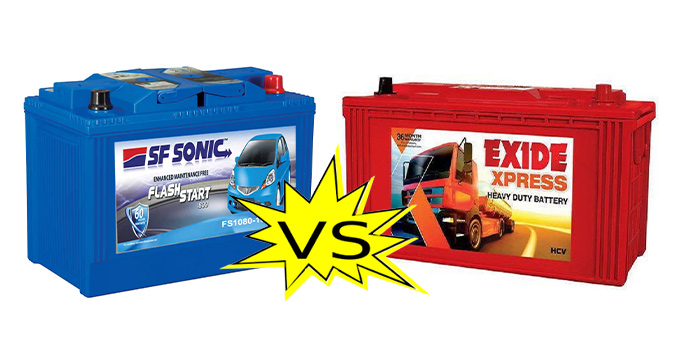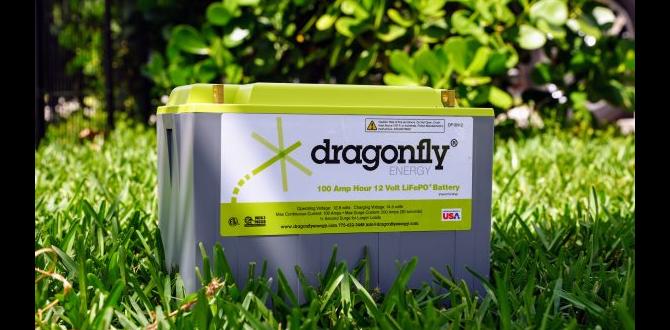Absolutely! You can find affordable gel car batteries that are excellent for electric cars, providing essential and reliable power. This guide breaks down how to choose and manage them for optimal performance and longevity, making battery power simple and successful.
Cheap Gel Car Battery For Electric Cars: Essential Power
Keeping your electric car powered up doesn’t have to break the bank. Many drivers wonder if a “cheap gel car battery for electric cars” is a real option. The good news is, yes, it is! But what does that mean for performance and safety? Many drivers get stressed when thinking about car batteries, especially for newer electric vehicles (EVs). It can seem complicated, with lots of technical terms. We’re here to make it super simple. We’ll walk you through what to look for, why gel batteries are a smart choice for EVs, and how to keep them running strong without spending a fortune. Get ready to feel confident about your EV’s power source!
Why Gel Batteries Might Be Your EV’s Best Friend
Electric cars have an auxiliary battery, usually a 12-volt one, that powers all the electronics – like your lights, radio, power windows, and the systems that get the big electric motor going. This is where a gel battery can shine.
Unlike traditional flooded lead-acid batteries, gel batteries use a silica-based gel inside. This means they don’t have free-flowing liquid acid. This design offers some fantastic benefits, especially for an EV:
- Deep Discharge Capability: Gel batteries can handle being drained more deeply without damage, which is great for the various power demands in an EV.
- Vibration Resistance: The gel electrolyte is more solid, making these batteries more resistant to shakes and bumps, common in any vehicle.
- Spill-Proof: Because there’s no free-flowing liquid, they are much less likely to leak, even if tipped. This is a big safety plus.
- Lower Self-Discharge: They tend to hold their charge longer when not in use, which is good for EVs that might sit for a while.
- Less Maintenance: With no need to check or top up electrolyte levels, gel batteries are virtually maintenance-free.
While you might see “cheap gel car battery for electric cars” advertised, it’s vital to understand that “cheap” doesn’t mean “low quality.” It often means a good balance of price and performance. For an EV, reliable auxiliary power is key, and a well-chosen gel battery delivers just that affordably.
Understanding Your EV’s 12-Volt Auxiliary Battery
It’s a common point of confusion: electric cars, despite using a massive high-voltage battery for propulsion, still rely on a smaller, conventional 12-volt battery. Think of this 12-volt battery as the starter for your car’s brain. It powers up all the essential low-voltage systems and tells the main high-voltage battery what to do.
What This 12-Volt Battery Powers:
- Dashboard lights and displays
- Infotainment system (radio, navigation)
- Power windows and locks
- Sensors and computer modules
- The initial boot-up sequence for the high-voltage system
When this small but mighty battery starts to weaken or fail, it won’t necessarily stop your car from moving immediately, but it can cause a cascade of electronic issues. You might see error messages on your dashboard, or the car might refuse to “start” its ready state. This is why maintaining this auxiliary battery is just as crucial as managing the main drive battery.
Choosing a “Cheap” Gel Car Battery: What to Look For
When you’re on the hunt for a cheap gel car battery for electric cars, the goal is to find a reputable brand that offers good value. “Cheap” should mean affordable, not flimsy.
Here are the key things to check:
- Battery Size and Type: EVs often use specific Group sizes for their 12V batteries. Check your car’s manual or the old battery for the group number (e.g., Group 24F, Group H6).
- Capacity (Ah – Ampere-hours): This tells you how much energy the battery can store. Match or slightly exceed the original battery’s Ah rating. More is usually better for longevity.
- Cold Cranking Amps (CCA): While EVs don’t “crank” an engine in the traditional sense, CCA is still a measure of the battery’s power output in cold conditions. A higher CCA rating generally means a more robust battery.
- Reservce Capacity (RC): This indicates how long the battery can supply a certain amount of power if its primary source fails. Higher is better.
- Warranty: Even for a cheaper battery, a decent warranty (e.g., 1-3 years) is a sign of the manufacturer’s confidence.
- Brand Reputation: Stick to known brands that have a good track record for reliability, even if they are on the more affordable end of their product line. Look for reviews.
Finding a price-conscious option doesn’t mean compromising on quality. It means being a smart shopper, focusing on the essential specs that ensure your EV’s auxiliary systems stay powered correctly.
Gel vs. AGM vs. Flooded Batteries for EVs
When considering a 12-volt battery for your EV, you’ll likely encounter three main types: Flooded Lead-Acid, AGM (Absorbent Glass Mat), and Gel. Each has its pros and cons, but for an EV’s auxiliary power, Gel and AGM are often preferred over traditional flooded batteries.
Let’s break them down:
| Feature | Flooded Lead-Acid | AGM (Absorbent Glass Mat) | Gel |
|---|---|---|---|
| Electrolyte Form | Liquid (needs maintenance) | Absorbed in fiberglass mats | Suspended in a silica gel |
| Position Mounting | Must be upright | Can be mounted in any position (except upside down) | Can be mounted in any position (except upside down) |
| Vibration Resistance | Poor to Moderate | Good | Very Good |
| Deep Discharge Tolerance | Poor (can be damaged easily) | Good | Very Good |
| Charging Speed | Moderate | Fast | Slower |
| Cost (General) | Cheapest | Mid-range | Mid-range to Higher |
| Maintenance | Requires regular checks | Sealed, maintenance-free | Sealed, maintenance-free |
For an EV, the spill-proof nature and deep discharge capability of Gel and AGM batteries make them superior choices. While AGM batteries can charge a bit faster, Gel batteries often have a slight edge in longevity and resistance to overcharging. Since “cheap gel car battery for electric cars” often refers to value, and Gel batteries last well, they present a compelling option for cost-conscious EV owners.
It’s important to ensure your EV’s charging system is compatible with the chosen battery type. Modern EVs typically have sophisticated charging systems that can handle Gel or AGM well, but always check your car’s manual. You can find more technical details on battery types from resources like the U.S. Department of Energy’s Office of Energy Efficiency & Renewable Energy, which often discusses battery technologies in vehicles.
Benefits of Using a Gel Battery in Your Electric Car
Choosing a gel battery for your EV’s 12-volt system brings several advantages:
- Extended Lifespan: Gel batteries are known to have a longer service life than flooded types, meaning fewer replacements over time.
- Reliability in Varied Climates: They perform well in both hot and cold temperatures.
- Safety First: Their sealed, spill-proof design reduces the risk of acid leaks, protecting you and your vehicle’s components.
- Consistent Power Delivery: They offer stable voltage output, crucial for sensitive electronics in modern EVs.
- Peace of Mind: Being maintenance-free means one less thing for you to worry about.
So, when you’re looking for a “cheap gel car battery for electric cars,” you’re actually looking for a cost-effective way to get these significant benefits. It’s about smart investment, not cutting corners.
Potential Downsides to Consider
While gel batteries are great, especially for EVs, it’s wise to be aware of potential drawbacks:
- Slower Charging: Compared to AGM batteries, gel batteries can charge at a slower rate. This usually isn’t an issue for an EV’s 12V system, as it’s topped up when the car is plugged in or running, but it’s good to know.
- Sensitivity to Overcharging: While robust, overcharging can damage the gel electrolyte. Modern EV charging systems are usually smart enough to prevent this, but older or improperly configured systems could pose a risk.
- Higher Upfront Cost (Sometimes): While we’re looking for “cheap” options, sometimes even entry-level gel batteries are slightly more expensive than basic flooded ones. However, the longer lifespan often offsets this.
For most EV owners, the benefits of using a gel battery far outweigh these minor concerns, especially when selecting a quality, affordable option.
How to Safely Replace Your EV’s 12-Volt Battery
Replacing a car battery might sound intimidating, but with the right steps and safety precautions, it’s a manageable DIY task. For an EV, there’s an extra layer of caution because you’re working with electrical systems, even if it’s just the 12-volt one.
Safety First is paramount! Always refer to your vehicle’s specific owner’s manual for the exact location of the battery and any model-specific procedures.
Tools You’ll Need:
- New Gel Car Battery (correct size and specs for your EV)
- Socket set or wrench set (typically 10mm, 13mm)
- Gloves (work gloves or nitrile gloves)
- Safety glasses
- Terminal protector grease (optional, but recommended)
- Memory saver (optional, to keep settings like radio presets)
- A small brush or terminal cleaner
Step-by-Step Replacement Guide:
- Park Safely and Power Down: Ensure your electric vehicle is parked on a level surface, in park (or neutral with the parking brake engaged), and completely turned off. Open all doors and ensure nothing is pressing the “start” button or engaging the vehicle.
- Locate the 12-Volt Battery: In many EVs, this battery is located in the front trunk (frunk) or sometimes under a seat or in the engine bay. Consult your manual.
- Ventilation: Work in a well-ventilated area.
- Disconnect the Negative Terminal FIRST: Using your wrench, loosen the nut on the clamp for the negative (-) terminal (usually black or marked with “-“). Gently twist and pull the cable off the terminal. Tuck it away so it can’t accidentally touch the battery post. This is the most critical safety step to prevent short circuits.
- Disconnect the Positive Terminal SECOND: Now, loosen the nut on the clamp for the positive (+) terminal (usually red or marked with “+”). Remove the cable and set it aside, making sure it doesn’t touch any metal parts of the car or the negative terminal cable.
- Remove Battery Hold-Down: Batteries are typically secured with a bracket or strap. Loosen and remove the bolts or nuts holding this bracket in place.
- Remove the Old Battery: Batteries can be heavy! Lift the old battery straight up and out. If it’s heavy, get help. Be careful not to tilt it too much, even though it’s gel and less prone to spills.
- Clean Terminals and Tray: Inspect the battery tray for corrosion and clean it. Use a wire brush or terminal cleaner to remove any dirt or corrosion from the cable clamps.
- Install the New Gel Battery: Carefully place the new gel battery into the tray, ensuring it’s oriented correctly.
- Secure the Battery: Reinstall the hold-down bracket and tighten the bolts/nuts to secure the battery. It should be snug but not overtightened.
- Connect the Positive Terminal FIRST: Place the positive (+) cable clamp onto the battery’s positive terminal. Tighten the nut securely. You can apply terminal protector grease now to prevent future corrosion.
- Connect the Negative Terminal SECOND: Place the negative (-) cable clamp onto the battery’s negative terminal. Tighten the nut securely.
- Final Check: Ensure both terminals are tight and the battery is secure.
- Test the Vehicle: Close all doors. Get in and attempt to “start” your EV as you normally would. Check that dashboard lights come on and that systems are functioning correctly.
If you’re uncomfortable with any part of this process, it’s always best to have a professional mechanic perform the battery replacement. Many auto parts stores also offer battery testing and installation services.
Maintaining Your Gel Car Battery for Longevity
Gel batteries are low-maintenance, but a little care can extend their life significantly, ensuring your “cheap gel car battery for electric cars” serves you for the longest possible time.
- Avoid Deep Discharges: While they tolerate them better than flooded batteries, consistently draining them very low can still reduce their lifespan.
- Keep Terminals Clean: Periodically check the battery terminals for corrosion. Clean them with a wire brush and apply protector grease if needed.
- Ensure Proper Charging: Modern EVs usually manage this automatically. If you use an external charger, ensure it’s designed for gel batteries and set to the correct voltage. Gel batteries typically require a slightly lower charging voltage than AGM or flooded batteries.
- Secure Mounting: Make sure the battery remains securely fastened. Excessive vibration can still affect any battery over time.
- Monitor Performance: Pay attention to any slow starting, dim lights, or warning signals. These can be early indicators that a battery is starting to age.
By following these simple tips, you can maximize the performance and lifespan of your affordable gel battery.
When to Consider Battery Replacement
Even the best batteries don’t last forever. Here are signs that it’s time to think about replacing your EV’s 12-volt gel battery:
- Slow or Weak Electronics: Lights dimming when using other accessories, slow power windows, or a sluggish infotainment system can be early signs.
- Dashboard Warning Lights: Your car might display a battery warning light or other electrical system error messages.
- Difficulty “Starting”: The car might take longer to become “ready” to drive, or you might hear unusual clicks or whirring sounds during the startup sequence.
- Battery Age: Most 12-volt auxiliary batteries in EVs have a lifespan of 3-5 years. If yours is older, it might be nearing the end of its life, even if it’s functioning normally.
- Corrosion on Terminals: While cleaning can help, excessive green or white powdery buildup can indicate an underlying issue and might mean the battery is failing.
Don’t wait until you’re stranded. If you notice any of these symptoms, it’s wise to have your battery tested. Many auto parts stores offer free battery testing. Finding a quality “cheap gel car battery for electric cars” proactively can save you from unexpected trouble down the road.
Finding Affordable Gel Car Batteries: Tips and Tricks
The term “cheap gel car battery for electric cars” implies a desire for affordability without sacrificing essential quality. Here’s how to find the best value:
- Shop Around Online: Compare prices from major online retailers. They often have competitive pricing and a wide selection.
- Check Local Auto Parts Stores: Many chains run sales and promotions. Don’t hesitate to ask about their best deals on gel batteries.
- Look for Sales Events: Holidays and end-of-seasons are often good times to find discounts.
- Consider Reputable Budget Brands: Some brands specialize in offering good quality at lower price points. Do your research and read reviews.
- Ask a Mechanic: Your trusted mechanic might have recommendations for reliable, affordable battery suppliers.
- Know Your Specs: Before you shop, be sure you know the exact Group Size, CCA, and Ah rating your EV requires






